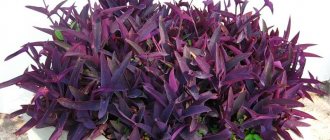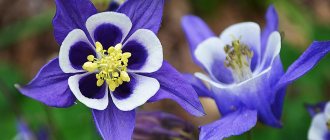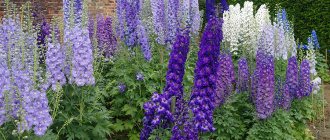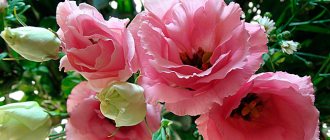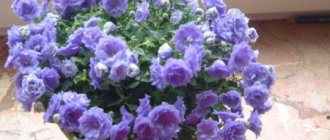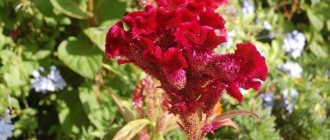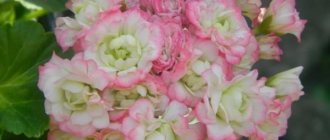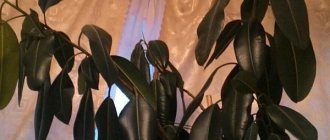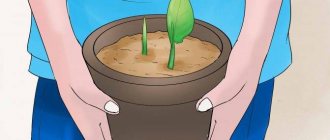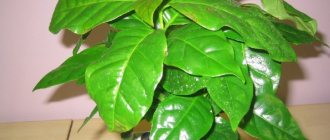Caustic sedum description, photo planting and care, succulent, flowering, beneficial properties, medicinal use, active ingredients, contraindications
Acrid sedum - (Sedum acre L.), family Crassulaceae. Common names: bitter wall pepper, rock pepper, bird's bread, warty grass. A herbaceous plant with a creeping or rising stem up to 5-15 cm in height, with small rolled fleshy leaves and shiny yellow flowers. It is found in dry, sunny places, on walls, stones, and on roadsides. It is very rarely used as a blood pressure lowering agent in folk medicine - for poorly healing wounds, in homeopathy for bleeding hemorrhoids.
Caustic sedum
Latin name Sedum acre L.
Family Crassulaceae
Description
Sedum ácre is a herbaceous perennial belonging to succulents. The plant of the Crassulaceae family has been known to people since ancient times.
It is no coincidence that it has many other names - “rejuvenator”, “feverish or hernia grass”, “whip” and even “living water”.
Natural habitat - North Africa, Europe. In Russia, it is found naturally in western Siberia, Ciscaucasia. It chooses sandy and dry places for growth - wastelands, embankments, rocky slopes. Found on forest edges and clearings.
The rhizome of the sedum is thin, highly branched, resembling a bunch of tangled cords. Thanks to this rhizome, the plant receives enough moisture from the soil. During prolonged drought, the flower produces surface roots to catch droplets of dew and rain.
The rising stems of sedum do not exceed a height of 15 cm. Their height depends on the composition of the soil. On scanty rocky soil they reach only 7 cm, but under favorable conditions they grow to their maximum. The stems are covered with small, fleshy leaves that are ovoid in shape. Their color is green, and can be dark or light (depending on the planting location and lighting). Special fabrics of the sheet plate accumulate moisture.
The leaves do not fall off in winter; the succulent remains green throughout the winter.
The short inflorescences consist of golden-yellow flowers. Among the five opened petals, 10 stamens are clearly visible. The buds open in May - June, depending on climatic conditions. Flowering lasts until September, after which the seeds ripen. The plant is an excellent honey plant, producing a lot of nectar even in dry weather. Many insects are attracted by the sweet aroma of flowers.
Young bushes take root well and grow quickly. As soon as the short shoots touch the soil, they immediately try to cling to it. Over the course of the season, the succulent grows and by the next summer it is ready to delight flower growers with abundant, bright blooms.
There is a legend about the ability of sedum to be reborn. If you put dried sedum in the ground, sprinkled with soil, it will come to life and sprout!
Watering and fertilizing sedums
For the most part, sedums are drought-resistant and do not require a special watering regime. It is enough to moisten the soil under them occasionally, especially in the case of a long absence of rain or abnormal heat.
It is recommended to feed sedums during the active growing season - in spring and summer. In the fall, feeding should be stopped so that the plant can enter the dormant phase and prepare for wintering.
You can fertilize sedums when planting by adding a slow-release granular preparation to the soil - in this case, there will be enough nutrition for the entire season. Among modern complexes of prolonged action, you can choose Agrovitaqua-AVA, Osmokot Bloom or PrePlant, Bona Forte TURBO Universal - the volume of granules specified in the instructions is mixed with soil taken out of the planting hole.
If you don’t have such a complex at hand at the time of planting, you can use liquid fertilizer for succulents after 2-3 weeks (Agricola Aqua for cacti and succulents or Fusco Flower Happiness for cactus), but when diluting, make the proportion half as much as indicated in the instructions.
These amazing plants develop and look better if they grow in poor soils, but if overfed, they can lose their decorative properties.
Excess nutrition contributes to the rapid growth of shoots, which leads to elongation of the plant and an increase in the spaces between the leaves. For the same reason, you should not use fertilizers with a large amount of nitrogen for sedums.
On average, it is recommended to feed sedum twice a season. The first time you should apply fertilizer during budding (you can use 10% mullein infusion or urea at the rate of 30 g per 1 sq.m.), the second fertilizing with complex mineral fertilizer is carried out after the end of flowering.
Varieties
Sedum acre Aureum
Sedum acre Aureum
This variety of sedum is a decoration for alpine hills and rockeries. It grows quickly, forming lush mats, the height of which is about 8 cm. Small, fleshy green leaves are densely located on ascending stems. Shoots spreading along the ground quickly grow adventitious roots.
Flowering occurs from May to July. Golden-yellow flowers are collected in inflorescences. When they bloom, the green mat changes color, becoming yellow from the numerous opened flowers. During flowering, the foliage also acquires a yellowish tint.
Sedum Aureum is hardy and unpretentious: it is not afraid of drought and frost, and does not lose its attractiveness on poor soils.
Sedum acre Elegans
Sedum acre Elegans
The groundcover plant, reaching an average height of 10 cm, forms turf with a diameter of 20 cm. On branched stems, succulent leaves of green, bluish or purple color are alternately located. Their shape is slightly twisted. The foliage remains on the shoots throughout the winter. Abundant flowering begins in June and lasts about two months. The flowers are light yellow in color and have a diameter of approximately 1.5 cm. During flowering, the perennial “grows” up to 20-30 centimeters.
Sedum Elegance is planted in containers, on rocky walls and alpine hills. A separately planted plant looks impressive as a bright carpet spot or emphasizes the beauty of tall plant crops in the neighborhood.
Sedum acre Minus
Caustic sedum Minus
A very low-growing decorative variety of sedum acridus, forming a mat, the height of which barely reaches 10 cm. The fleshy leaves, which have a bluish-green color, look like small cylinders that turn pink in the sun. Blooms profusely with yellow flowers.
Sedum acre Minus
The flower is popular not only among professional flower growers, but also among beginners. It looks unusual both in group and single plantings. The plant is not afraid of frost.
Sedum in landscape design
Due to the fact that there are a large number of varieties with very different characteristics, sedum is often used to create landscape designs. Here's how sedum varieties are used:
- Low-growing and creeping varieties are planted in mixborders and on hills.
- Ground cover sedum is ideal for creating living flower carpets, edging borders and paths.
- Tall varieties of sedum are planted in groups.
- Sedum is planted in flowerpots and pots that are hung on the porch and around the site.
Features of cultivation
Sedum caustic is able to adapt to any climate. It requires a minimum of care; gardeners say about it: plant it and forget it.
Selecting soil and planting location
Sedum is not picky about soil fertility. On the contrary, it feels good in sandy, sparse areas. A loose clay-sand substrate is what the plant needs. You can add a little ash and humus to this mixture.
The simpler the soil composition, the more abundant the flowering.
If the flower is not picky about the composition of the soil, then good lighting is extremely important for it. It is best to plant it in the sunniest area. It will, of course, grow in the shade, but it will not please you with flowering.
Watering, fertilizers, fertilizing
Sedum growing in open ground requires virtually no watering. It receives the required amount of moisture from the soil and precipitation. Watering is needed only during the dry summer period, and then only moderately. Excessive waterlogging of the soil is detrimental to this type of succulent. In its natural environment, the perennial chooses dry areas for growth. There is no need to spray sedum.
The perennial does not need fertilizing. If you really want to feed it, it is enough to apply fertilizer for cacti once a summer.
Loosening
It is recommended to loosen the soil around young sedum bushes to prevent it from souring. In addition to loosening, mature overgrown “mats” must be weeded regularly.
Transfer
When transplanting several sedum bushes to a new location, it is important to maintain a certain interval between them - at least 25 cm. This distance is necessary for the growth of daughter shoots. You can replant throughout the warm season: from May to October.
Divisions or rooted cuttings are placed in the planting hole, sprinkled with soil substrate, and watered with a small amount of water.
Trimming
Pruning should be carried out in order to rejuvenate the sedum and give it a decorative appearance. The procedure can be performed at any time convenient for the grower, from spring to autumn.
The appearance of the perennial will itself indicate the need for pruning: with extensive growth and thickening, the color of young leaves will become faded, and the flowers will become sparse and very small.
In this case, the old stems of the sedum are removed, dried and deformed, and drooping flowers are also cut out.
Wintering
Adult specimens feel good at low temperatures, maintaining their attractiveness even under snow. Young bushes require winter shelter. They can be covered with fallen leaves or special covering material. In spring, release the sedum from its shelter.
What do we know about sedums
Sedums!!! My weakness, my tender love Elena, thank you so much for the article, I always look at all kinds of sedums with the greatest pleasure, and in your photo there is such beauty, I can’t take my eyes off it! Can I give you some of mine too - maybe you can help with the definition? I tried to figure it out somehow, but it turned out to be very difficult for a person ignorant of descriptions alone to do this with confidence. And I have several grown from seeds (a mixture of species). Well, the rest, in general, also appeared in different ways - and all without “passports.” So with confidence I only recognize the visible sedum (I have the usual one, I still dream of getting hold of the variegated form - I saw it from a friend) and the caustic sedum brought from the nearest slope)) But the rest...
In the last photo of the article I happily recognized one of the new inhabitants of my garden:
This is it - Sedum spurium 'Variegatum'? In my opinion, I have several representatives of this species, although I have lingering doubts here too. Here, for example, is one - in early spring it is very similar to Sedum spuium 'Voodoo'
But with the arrival of warmth, its leaves turn green, only the red edge remains, and even then not on all of them. In the next photo - it’s next to the blooming white sedum (I think)
And this is what the inflorescence looks like close up
It is this sedum that blooms twice for me: at the height of summer and in late autumn, until the snow. The second time, not so abundantly, but regularly, unlike its counterparts, which may or may not bloom in the fall. And there are several brothers:
This one - with pink flowers - has leaves that also have a red-brown border in the spring, and then it disappears, and in the heat it is just green
This one, it seems, has not moved from the old site (In any case, neither last summer nor this summer I saw exactly these flowers in my “kingdom of sedums.” And two more - I still can’t understand: is it one and the same, or still different... Here's one:
And here's another one:
In the photo, where they are not yet blooming, it is noticeable that their shoots are different:
And they also bloom at different times: the pure yellow one blooms earlier - a shoot with an inflorescence is already visible on the left. The yellow-orange one (the bush on the right among the stones) blooms 2 weeks later. It was sold as Sedum rupestre - subulate sedum. But after reading the description of this species on the Internet, I was completely confused (((Maybe you can clarify this question? What is still growing on me?
Now it’s the turn of those from seeds))) Here is the first copy:
In this form, I planted it in the ground. After a very short time it looked like this:
And here it is last year in early spring:
On the one hand, it looks like a white sedum:
Is this him? I'm not wrong? I don’t remember where this specimen came from, but for many years it has been living in the garden just like a white sedum, although this may be a misconception)) So, at first glance they seem to be similar, but since both of them grow nearby from each other, there are noticeable differences: the one from seeds is larger, “meatier”, and “in the massif” looks a little different.
This is a white sedum at the old dacha (I’ll call it that for now, but correct me if I’m wrong). I really hope for you - you will help me understand this issue too? And I’m posting the following, it also looks like these two:
Here it is from a slightly different perspective:
And he is in the company of others, including the one I asked about before:
The third type from the same package of seeds differs noticeably from the previous ones. In the next photo he is on the right, next to the sedum
Another angle, here the shoots are visible:
And here are its buds (it has small flowers, collected in a very loose inflorescence on a tall thin peduncle)
This is what it looks like blooming, next to other sedums; there are inconspicuous flowers on the left - that’s it))
And finally, a question that has been bothering me for a long time. The spring before last, in the forest near the river, I saw this plant:
This is also a sedum?.. Then, already in the summer, in the fields I met the same plants already blooming (August):
The inflorescence on a high peduncle looks like this:
What kind of plant is this?
If it is a sedum, then it probably reproduces like all sedums - easily? That's a lot of questions at once)) Sorry, the comment turned out to be very long - probably because the topic is very close to me. I hope you’re not mad at me for this, and will help me sort out my pets so that they all get “first and last names,” otherwise it’s somehow awkward even in front of them. Last edited on February 3, 2015, 3:07 pm
Reproduction methods
Sedum acrid can be propagated in three ways.
Cuttings
Cut off the shoot for planting with a sharp knife. Remove the lower leaves. Plant it in a loose substrate for rooting to a depth of one node. Plant the rooted cuttings (after 3-4 weeks) in a permanent place.
In spring, cuttings can be rooted immediately in open ground, when frost has passed. In autumn, cut shoots should be placed in water until roots appear. Then plant them in separate containers. In the spring, transplant into an open area using the transshipment method for continuous growth.
Seeds
It is better to sow seeds in March. After sowing, they must undergo a stratification (hardening) procedure. Seeds in a planting container are placed in a cool place for 2 weeks. After this, they are placed in a warm place for germination with a temperature of at least 18 degrees. The top of the box must be covered with film or transparent glass to create a greenhouse effect. The crops are ventilated daily and moistened as the soil substrate dries.
In about 25–30 days, the first shoots will emerge. Seedlings are picked when two strong leaves appear.
At the end of May - beginning of June, seedlings are planted in open ground in a permanent place. The distance between plants should be at least 10 cm for further growth. Sedum blooms in the third year after planting.
Dividing the bush
Dig up a heavily overgrown bush and divide it into several parts, each of which should have a growing point. Sprinkle sections of the root system with charcoal or treat with fungicides. Replant to a new site.
How to care for sedum
Although care is virtually unimportant for plants like sedum, a succulent will look more beautiful if you give it a little attention. To do this, you need to carry out the following garden manipulations.
Watering
The first thing to remember: waterlogging is one of the causes of sedum pain. Therefore, you can water the succulent only with a moderate amount of water after the earthen ball has completely dried out. Adult specimens are even less demanding on the level of humidity: even in dry summers, rare watering is enough for them.
Top dressing
Sedum is absolutely undemanding in terms of soil nutrition. To make the plant lush and even more beautifully flowering, fertilizers are applied twice. Feeding scheme:
- Before flowering. A solution of cow manure or a handful of ammonium nitrate is added under the plants.
- After flowering. To replenish the supply of macro and microelements, sedum is fed with complex mineral fertilizers in accordance with the instructions.
It is impossible to apply nitrogen fertilizers more often, as this will have a bad effect on the plant’s resistance to low temperatures.
The main sign that the plant needs nutrients and sunlight is pale or yellowed leaves. If the condition does not improve after feeding, the flower is transplanted to a sunny place.
Weeding
Perennial sedum does not get along well with weeds in the same area, so they need to be pulled out immediately after they appear. So that the soil does not become crusty and is maximally saturated with oxygen, the soil around the flower is loosened. To decorate the flower, they surround it with bark or pebbles.
Transfer
The root system of the sedum lies in the upper layers of the soil and is not particularly powerful. Therefore, it is not recommended to frequently replant the plant from place to place. As a last resort, 1-2 picks per year are allowed. Rejuvenating sedum planting is carried out every 5 years.
Shelter for the winter
On the eve of cold weather, sedum is pruned. Heat-loving varieties are mulched and covered with lutrasil. As soon as full warmth arrives, the shelter is removed.
Whatever the variety of sedum, planting and caring for it in open ground does not require special skills or a lot of time. Even a busy person or an inexperienced summer resident can grow a succulent on their own plot.
Diseases and pests
Sedum is one of those plants that are practically not susceptible to diseases and pests. The development of bacteria is often caused by improper care.
Overwatering causes rot to damage the succulent. The main signs of the disease are gray or black spots on the entire surface part. The areas affected by bacteria are cut off with a sharp knife and destroyed, and the sedum itself is sprayed with a fungicide. Watering is carried out only after the soil has dried out.
Among insects, aphids, nematodes and weevils are dangerous for sedum.
- To prevent small black pests that damage leaves, plants are sprayed with a weak insecticide solution. Please note that a strong concentrate cannot be used as it will burn the delicate leaves.
- Nematodes live in the root and quickly destroy it. The appearance of unexpected guests can only be detected by the appearance of the above-ground part of the plant. Flowers with fading foliage are dug up along with a lump of earth and taken away from the site.
- Weevils that eat the fleshy leaves are collected in a bag and destroyed.
Diseases and pests
Excess and stagnation of moisture in the soil can provoke the formation of rot on the root system. The disease spreads quickly if it is not stopped in time.
The “sluggish” leafless shoot needs to be dug up, the rotten roots should be cut off, and the cuts should be sprinkled with coal. Plant the reanimated plant in a new area. Another way to save it is to root the top of the succulent.
The roots of perennials are often affected by a fungal infection, which manifests itself in the form of swellings, growths and death of rhizome tissue. The methods of control are the same as for the formation of rot. Healthy parts are treated with fungicides.
The most dangerous pest for sedum are nematodes.
Their appearance is indicated by the appearance of the flower: sluggish, drooping shoots. The sedum stops growing. Swellings form on the roots. Necrosis of the root system leads to the death of the entire sedum. There are no means to combat parasites yet. The infected crop must be dug up and burned. You can plant marigolds or garlic in this area; other plants will become new victims of pests.
How to plant sedum in open ground
Whether the flower will take root or not depends on how the planting is done. But before you begin the decisive manipulation, you need to carefully prepare.
How to choose a seedling
The best place to buy sedum flowers is at a nursery. For planting, you should choose only healthy seedlings without mechanical damage and traces of diseases and pests. The leaves should be alive and turgor, and the soil in the container should be clean.
When choosing a plant, it is worth considering the fact that low-growing varieties are more suitable for creating living carpets, and tall ones are more suitable for single plantings.
In our nursery in Tatarstan you can purchase high-quality sedum seedlings for every taste. The company delivers orders throughout Russia, so you can buy sedum in Moscow or any other city if you are a wholesale buyer.
Selecting a location
Like most succulents, sedum grows well in sandy and rocky soils. Despite this, the plant can live on any other soil that drains water well. You should not plant a flower in an area with marshy soils or in lowlands where water often accumulates.
As for lighting, it is better to plant sedum in a well-lit place, unless the description of the purchased specimen says otherwise. It is undesirable for shrubs and trees to grow nearby.
Sedum planted in the shade quickly loses its decorative effect. The leaf blades become thinner and the stems become elongated.
Soil preparation
Most varieties of sedum are not demanding on the composition of the soil. At the same time, some ground cover varieties prefer to grow in garden soil rich in microelements, while others thrive in loam or sandstone.
For example, sedum sedum Purple carpet belongs to the first category, sedum prominent - to the second. Therefore, before buying the sedum you like, you need to find out whether it will be possible to fulfill the requirements of the plant.
A universal soil mixture for succulents is prepared from leaf and turf soil, sand, rotted manure mixed in a 1:1 ratio. A handful of wood ash is added to the finished substrate.
Landing dates
Sedum is planted in the second ten days of May, when the risk of return frosts is reduced to zero. In the southern regions, the favorable time comes earlier, and in the northern regions - later than the specified date.
The flower is planted following this pattern:
- At the selected location, dig holes with a diameter of 50 cm and a depth of 20 cm. To prevent plants from interfering with each other’s growth, 20 cm of free space is left between them.
- A layer of drainage material is placed at the bottom of the planting hole: pebbles, gravel or broken bricks. This will improve the outflow of water and prevent fungus from developing.
- The hole is filled 2/3 with soil mixture.
- The seedlings are placed in the center and the straightened roots are sprinkled with soil.
- The plant is watered abundantly.
Useful properties and contraindications
A representative of the Crassulaceae family has medicinal properties. Decoctions and ointments, which include sedum, are used to treat skin inflammations and pustules, calluses, and remove warts. It is necessary to carefully lubricate only the diseased areas; healthy skin can be burned.
In homeopathy, preparations with plant juice are used as laxatives and diaphoretics. They help relieve epilepsy attacks.
Do you have any doubts about what to plant in your garden plot? Plant caustic sedum - a minimum of care for this representative of the flora will save time for busy gardeners. And the result will not be long in coming - sunny inflorescences and decorative foliage will evoke only positive emotions.
Types and varieties of reports with names and photos
There are many varieties of sedum, and about a third of them are cultivated. Cold-resistant varieties and species are grown in garden plots and in city flower beds. As for tropical varieties, they have found their place in home floriculture.
Common Sedum
It is a medium-sized perennial up to 60 cm high. It has shortened roots and strong fleshy shoots with the same succulent foliage. The inflorescences are apical, multi-flowered, gradually changing color from green to muted pink, and then to purple-burgundy.
Sedum Caustic
A winter-hardy, unpretentious plant that can be found in the wild in Russia. The name “caustic” was given to it for a reason. The juice of plants of this species can corrode the skin to ulcers, so handling it requires special care. Low bushes are densely covered with leaves that do not fall off even in cold weather. It blooms with bright yellow small quinquefoil buds, forming a dense clump, painted in calm yellow-green tones.
Sedum False
Mountain variety with increased winter hardiness. Shoots of a horizontally ascending type, colored dark burgundy. Intertwined, they create a dense carpet of uneven height, blooming in purple-violet color. Forms corymbose-type inflorescences.
Sedum Vidny
This variety is native to eastern countries. The bushes are of medium height (about half a meter), the leaves are opposite, green in color with a slight bluish tint. Has many varieties that bloom in purple, violet and lilac tans. Based on this variety, many varietal lines have been developed. The most popular have become dark-flowered varieties and hybrids, for example, such as “Black Jack” or “Matrona” with dark purple shoots, the same color veining along the green leaf and inflorescences painted in purple tones.
Sedum Lydian
It is a very unpretentious ground cover with gray-green foliage that can take on a pink tint when grown in open, sunny areas. Blooms with pink buds.
Sedum White
Another ground cover variety that forms a dense covering carpet. When grown on fertile soil, it can behave aggressively, displacing neighboring plants. Star-shaped white-pinkish flowers bloom in large numbers on low peduncles, which the plant actively expels in mid-summer. With the onset of the first cold weather, the foliage begins to change color from green to purple, and in some varietal varieties, for example, the Murale variety, to purple.
Sedum Rocky (Bent)
A variety of original appearance, producing fluffy green shoots with fleshy, needle-like foliage. It forms small but very pretty curtains, from which tall peduncles with yellow buds grow.
Stonecrop Kamchatsky
It is distinguished by strong branching and has lanceolate-toothed foliage, the color of which depends on the variety. This species also has a variegated variegated variety.
Sedum Evers
A shrubby plant with woody shoots. The green leaf blades have a rounded shape. The paniculate-type inflorescences are very lush, quite dense, and harmoniously combine with oval foliage. Looks great in the design of garden paths, rock gardens and among decoratively laid stones.
Sedum Siebold
The shoots are ampel-type with a length of up to 25 cm. The foliage is painted in a very beautiful green-ash shade, which goes well with the pale lilac buds. Very attractive in appearance, but rather capricious in appearance. It does not retain its decorative effect for long.
Morgana sedum
Produces creeping shoots that can reach a meter in length. The leaves are rounded-pointed, small in size, alternate in arrangement. Due to their close growth and tight fit, the shoots look densely leafy. It blooms with red inflorescences and looks very impressive in hanging flowerpots.
Sedum thickleaf
An interesting semi-shrub variety with cylindrical leaves of a muted gray-green color. The tips of the leaves are bluntly rounded and gradually change their color to red. Blooms in yellow or green.
Sedum Spanish
The ground cover is bluish-green, turning to pink. The more sun this sedum receives, the more pink its curtain becomes. It has a tendency to actively self-sow, which is why it often poses a threat to the plantings of neighboring crops. The buds are painted white.
Sedum Multistem
It has an external resemblance to the Evers sedum, but does not grow to such sizes. Its height barely reaches 20 cm, and in dwarf varieties it is half as much. This variety of sedum is considered one of the most capricious in planting and care.
Use in folk medicine
Due to its benefits, sedum is widely used in folk medicine, having diuretic, healing and antiseptic properties.
- Sedum infusion is used in the treatment of malaria: half a glass of decoction of 1 teaspoon of dry herb and 250 ml of boiling water is drunk three times a day after meals.
- The decoction is also drunk for stomach cancer as an adjuvant to relieve the side symptoms of radiation therapy.
- An ointment made from sedum juice and butter heals and also disinfects open wounds.
- Using the herb, compresses are made to relieve attacks of rheumatism.
Important! To ensure that the use of caustic sedum does not harm your health, you should consult a doctor before using it.
Caustic sedum - how to get rid of it
A plant with a branched but shallow root system is quite easy to weed out. However, over time, the seeds, carried by the wind, germinate again, which makes the crop look like a weed. To remove sedum from the site completely, it is recommended to sift the soil manually. Although this procedure will not give a 100% result the first time.
Advice! To ensure that the procedure for removing caustic sedum from the garden is not so painful, you should not allow the seeds of the crop to be dispersed uncontrolled.
Thus, sedum is a spectacular ground cover succulent, which, subject to agrotechnical requirements for cultivation, can easily be used to decorate a rock garden, flower garden and as an unpretentious, quickly growing lawn.
Common sedum (Sedum telephium)
Another frost-resistant perennial is the common sedum, growing as a lush bluish-green bush about 50 cm high. This species is found in the European region and is interesting for its ability, during the flowering process, to change the color of the inflorescences from pink to rich burgundy.
Common sedum looks great in single and group plantings, is good for cutting and can decorate a winter garden with its lush, bright umbrellas if you leave them on the shoots until spring.
The Matrona variety is one of the most popular and beloved by gardeners; it is often chosen for growing in the middle zone due to its high frost resistance and original appearance. Tall, erect stems of a reddish color are covered with green foliage with a purple tint, and at the tops there are huge lush pinkish-red inflorescences.
Sedums amaze with their species diversity and ability to survive in the most difficult conditions. These fragile-looking, lushly flowering succulent plants combine Nordic character and Eastern stubbornness. Real tough fighters for the difficult Russian winter!
Sedum dasyphillum
Sedum is found naturally on the Mediterranean coast, as well as in Europe and North America.
This sedum is distinguished by bluish leaves with a bluish tint, tightly seated on the stems, which turn purple in the cold season. Short creeping shoots take root easily and form a dense ground cover. Due to its short stature, this species of sedum was nicknamed dwarf.
The dense-leaved sedum blooms in August–September with unremarkable small white flowers, and flowering is not at all its main advantage. More importantly, plants of this species are frost-resistant and are able to keep their original foliage intact even in severe cold.
Sedum reflexum, or rocky (Sedum reflexum)
Sedum reflexum grows into a low, dense carpet. Its fluffy shoots with small subulate-shaped leaves resemble small fir trees, and above them in mid-summer peduncles about 30 cm high with bright yellow flower panicles appear.
Sedum rock is very decorative and at the same time hardy. Its dense leaves of a green or bluish tint “hold” tightly to the stems and remain in their original form all year round. This sedum is resistant to the harsh winter conditions of the middle zone, and it tolerates drying out of the soil much more easily than waterlogging.
One of the most interesting varieties of rock sedum is Angelina, beloved by gardeners for its bright yellow foliage, which turns a rich orange hue in the fall. Also popular is the variety Kristatum, whose shoots resemble writhing, fluffy caterpillars.
Possible difficulties
- Mealybug. The pest attacks the leaf axils. It is necessary to remove insects using a cosmetic stick, after which the plant is treated with an insecticide.
- Wilting of leaves. Indicates insufficient watering.
- Rotting of the roots and base of the stem. Indicates that the soil is too wet and the temperature is low. You should moderate watering and move the plant to a warmer place.
- Falling leaves after transplantation. This is a natural manifestation of the plant's establishment in new soil. It is necessary to give the sedum time to recover.
- Pulling out internodes. This happens due to a lack of lighting. The plant is moved to a sunnier place or kept under a lamp for some time.
Such an unpretentious plant as sedum burrito can be mastered even by a novice gardener. By following simple rules of care, you can add this unusual representative of succulents to your collection of decorative favorites for many years.
